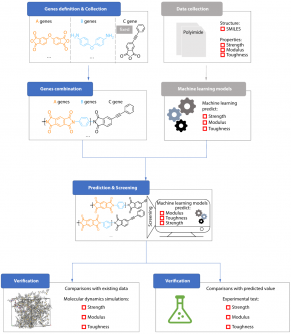UPDATE: A groundbreaking study from the East China University of Science and Technology has unveiled an AI-assisted materials-genome approach that significantly accelerates the design of ultra-tough polyimide films, crucial for aerospace and flexible electronics. Published on September 2, 2025, in the Chinese Journal of Polymer Science, this innovative method promises to overcome longstanding challenges in polymer design.
Polyimide films are vital for their exceptional thermal stability and insulation properties, yet traditional methods of optimizing their mechanical performance have been slow and inefficient. High modulus often comes at the expense of toughness, complicating the development of well-balanced materials. The new AI-driven approach, however, allows for rapid design and testing of thousands of candidate structures, marking a significant leap forward.
The research team employed a machine-learning model that predicts key mechanical parameters—Young’s modulus, tensile strength, and elongation at break. This model was trained on over 120 experimental datasets, making it capable of accurately assessing 1,720 phenylethynyl-terminated polyimides (PPIs). Remarkably, a new formulation named PPI-TB emerged from this process, surpassing well-known benchmarks like PETI-1 and O-O-3.
The AI models achieved impressive predictive accuracy, with R^2 values around 0.70–0.74 for all three mechanical metrics. Molecular dynamics simulations confirmed the performance of PPI-TB, which exhibited a modulus of 3.48 GPa, demonstrating superior toughness and strength.
“This synergy between data science and chemistry allows us to explore material possibilities that would take decades by conventional means,” stated Prof. Li-Quan Wang, a leading author of the study. “By translating polymer fragments into genetic-like descriptors, we can treat molecular design like decoding a genome.”
The implications of this research are profound. By integrating AI predictions with molecular interpretation, the team is revealing essential structure-property rules that will accelerate polymer innovation. This approach provides a universal framework for designing polymers with targeted combinations of stiffness, strength, and flexibility—traits essential to advancing various technologies, including microelectronics and aerospace composites.
As industries seek lightweight, durable materials, this AI-driven strategy could drastically reduce the cost and time associated with polymer development. The method not only replaces years of experimental iteration with predictive modeling and virtual screening but also opens doors to other high-performance polymer classes beyond polyimides.
Looking ahead, the research team anticipates that this pioneering approach will guide the creation of next-generation materials that power the future of electronic and aerospace technologies. As the world moves towards smarter, more efficient materials, the potential for impact is enormous.
Stay tuned for more updates as this exciting development continues to evolve, reshaping the landscape of polymer science and engineering.







